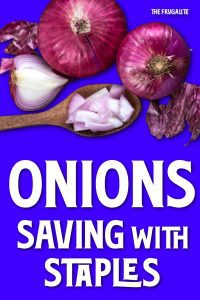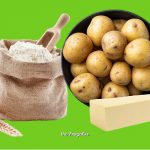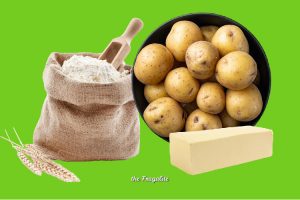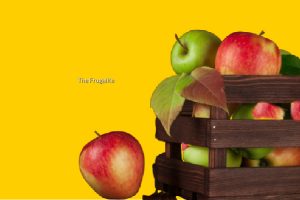(Psst: The FTC wants me to remind you that this website contains affiliate links. That means if you make a purchase from a link you click on, I might receive a small commission. This does not increase the price you’ll pay for that item nor does it decrease the awesomeness of the item. ~ Daisy)
By the author of the FREE online course Growing Self-Sufficiency: The Whole Picture
Saving with Staples is a series where I look at a pantry staple and consider its nutritional value. Then, I investigate the economics of this staple: what is the most cost-effective way to buy it? Finally, I offer some suggestions on how to eat and serve this staple to get the most benefit from the savings that it offers.
While onions are generally not an overly expensive vegetable, they are rarely the main “dish,” so to speak. That doesn’t mean that their supporting role in meals isn’t important. In fact, I would argue that eating more onions can save you a lot of money! Another benefit of onions is that they generally store well at room temperature or a bit below, and they don’t need high humidity to stay edible.
Let’s see how onions add up as a staple to save with.
Health Benefits of Onions
When a Registered Dietician calls a vegetable “highly nutritious” that is something that I pay attention to. I think it also takes a lot for a dietician to call the health benefits of a vegetable “impressive.” Yup! That’s onions!
So, if you were thinking the onion is a second-tier vegetable, think again! Here is a list of the many health benefits of this impressive vegetable:
1) High in nutrients: These include potassium, B vitamins, and vitamin C.
2) Good for your heart in multiple ways: Onions contain antioxidants that can be anti-inflammatory and reduce blood cholesterol. Not just one or two: how about at least seventeen different anti-oxidants! That’s good news for your blood pressure and your heart.
3) Anti-cancer properties: Some antioxidants found in onions have been found in research to inhibit tumour growth. There is also a sulphur-containing compound in onions that acts in a similar way.
4) Help manage blood sugars: This is another benefit of some of the antioxidants and sulphur compounds in onions.
5) Increase bone density: This may seem like a strange benefit for a vegetable, but many studies have shown that people who eat more onions have sturdier bones.
6) Antibacterial properties: Onion extract has been shown to kill several dangerous types of bacteria.
7) Improve gut health: We now know more than ever how important it is to feed the good bacteria in our gut. Onions contain that important type of fibre that they like to eat.
[Source]
What are the frugal ways to buy onions?
I compared a number of ways to buy onions as I prepared this article. While the prices may vary from region to region, I am pretty sure that this ranking would not vary unless there were a very good sale on. In my region, the most common way to get onions is in a bag. The price for 3 pounds of yellow onions at a popular local discount grocery store is $2.25. For 3 pounds of organic onions, you’re going to pay double that. Would you like organic red onions? That will cost almost triple the price of the yellow onions.
Are you concerned about pesticides on your onions? In terms of the “dirty dozen” (more pesticide residue) and “clean fifteen” (less pesticide residue) that some may be aware of, this year, onions come in at number 43, so they are a member of the “clean fifteen.” So, if your budget is tight, you could only buy organic varieties of the items on the “dirty dozen” list. By doing that, you will save a lot, as we have seen from the prices of organic onions!
In terms of buying onions, the saying could be, “The more, the merrier.” I have always found that I save on onions when I buy a 10-pound bag, as compared to a 3-pounder. However, these are not always available.
At harvest time, there may be more options for you. Some grocery stores in our area offer 10 lb bags in the fall. You may be able to contact a local farmer to ask if you can glean his fields in exchange for some produce. You may be able to place a bulk order with a local farmer and use a dry, cool storage room to extend the life of your onions.
Here are a couple of cautions when it comes to buying onions. If you want to save time and buy frozen pre-chopped onions, you are going to pay dearly for the time saver: Add another 50% to the cost of yellow onions in a bag for frozen chopped onions.
If you want to buy dehydrated, chopped onions, be aware that you will be paying ten times the price of yellow onions in a 3-pound bag. You might want a few for long-term storage, but buying these all of the time would get expensive!
You should also be cautious about buying onions regularly individually. Think that you’re getting a fair price for that onion? Think again! At our local discount store, individual onions are charged by weight at a price more than twice what you would pay when you buy a three-pound bag!
I hope seeing these differences in prices opens your eyes to how you might save when you next buy onions. Even a small change, like substituting a bulk bag of onions for an individual onion, will help you save money.
Creative ways to use onions during lean times
When times are tough, I add onions to everything. They give me fiber to fill me up and lots of nutrition.
This past winter, I got to the bottom of my 10-pound bag of onions, and they were all starting to sprout. Rather than get discouraged, I threw them all in an aluminum roasting pan with some dirt. Hurray! I had fresh green onions for the rest of the winter!
When the 10-pound bags become available in the fall, you can save a lot of money by chopping a bag up, portioning it, and freezing the bags.
Here are some other ways to use onions along with pantry items in a way that saves you money:
Onion Snack
When I ran short of rutabagas to make latkes with this spring, I just added an onion in to make up the difference. They were delicious! I love making savory pancakes and throwing in onions, corn, rutabaga, and whatever I have on hand. I find these make delicious and healthy snacks, and they keep well.
Here’s a sample rutabaga latke recipe to get you started.
Onion Main Dishes
When I get to supper time without a plan, an onion omelet will always do the trick: a couple of beaten eggs and milk some chopped onion, and whatever herbs and spices strike my fancy. Voila! Supper!
In the cooler months, if you have never tried it, I highly recommend making French onion soup at least once in your life. Carmelized onions and cheese…what’s not to like?
 Onions are a pretty important part of a simple stew, like Irish stew, which is wonderful on cold days.
Onions are a pretty important part of a simple stew, like Irish stew, which is wonderful on cold days.
In the warmer months, I love to have chopped raw onion in all of my pasta and bean salads, along with whatever other veggies and fresh herbs I have on hand.
German Potato Salad, which can be served cold or warm, also features onions, along with potatoes, and bacon.
Onion Side Dishes
Carmelized onions can go on anything. They are great on burgers!
During BBQ season you can also grill onions as a tasty side dish.
If you like pearl onions, here is a great recipe to eat them creamed.
Onion Condiments
In my wonderful Mennonite cookbook, one of the books that I use to save money, I found a recipe to pickle plain white onion slices in a simple brine. The only ingredients are sugar, salt, dill seed, white vinegar and water. If you are in a pickle, and can’t afford pickles and you have some onions on hand, these could be delicious.
I highly recommend buying the More-with-Less Cookbook. So many of my favorite recipes come from there, and there are countless money-saving tips, too.
Onions: Savings to bring a tear to your eye
Onions are a frugal pantry classic with lots of potential for savings. Could you see yourself trying any of the thrifty tips offered here? Do you have one you can share with us? What is your favorite way to use onions? Please tell us in the comments section.
About Colette
Colette is passionate about sharing her knowledge of thrifty living and self-sufficiency. She has developed her skills in self-reliance living in the suburbs, the city, and more recently, on her own Half-Acre Homestead. Colette lived five years completely off-grid and without running water in an eight by 24 foot tiny home while designing and building her own 18 by 24-foot eco-cabin. Her website, Half Acre Homestead is attracting followers from around the world who want to become more self-sufficient. Colette invites you to stop by the Homestead and check out all of the great resources including the practical How To Guides, A Tiny Home Resource Center and her organic gardening stories on her blog. She shares her wholistic model (body/mind/spirit) for achieving self-sufficiency in her Free Course, “Growing Self-Sufficiency: The Whole Picture.” Stop by the Homestead today to register free of charge!











17 thoughts on “Onions: Saving with Staples”
Thank you for a great onion essay! I love onions and learning how healthful they are is icing on the cake! Your tips here give me ideas to use them even more. I’m looking forward to your series. Keep up the great work!
Paul
Hi Paul, Thank you so much for your kind words! I love onions, too, and doing the research for this article allowed to me learn more about their amazing health benefits! Please keep us all posted on anything new that you try with your onions. I’m sure all of the the Frugalites would love to hear about it. Wishing you the best!
By the way, Paul, If you are relatively new to the Frugalite community, you can find many in the Saving with Staples Series already online, including carrots, potatoes, tomatoes, oatmeal, and yoghurt! ENJOY!
I will look those up. Thank you!
Are the health benefits that same for raw and cooked onions? I can’t eat raw onions. They tear my stomach up. But I can eat onions that have been cooked in some way.
Hi Genevieve, Most of the onions I eat are gently sauteed in olive oil. Only on some dishes, I use a small amount of very finely diced raw onion. If you simply can’t tolerate raw onions, then I would go with what you can eat. I’m sure that many of the health benefits, like the fibre and at least some of the nutrients are retained after minimal cooking. What about onion greens? I find that they are more gentle to eat than raw cooking onions. If you sprinkle a few diced raw green onions into a salad, for example, you might be able to tolerate that and get some of the raw onion benefits. Let me know what you think. Wishing you the best!
The yellow onions from Walmart that I use have little stickers indicating whether they were grown in the US or Mexico. Even though the Mexico-labeled are a wee bit smaller, I’v read that Mexico does not allow the use of pesticides on such produce — unlike the US. So my choices are to either pay higher prices for US organic produce or save a little and buy the Mexico-labeled onions.
After peeling, I chop onions up finely and include them in multi-ingredient one-pot meals that I can steam to completion. I add spices after steaming is complete. Cleanup is much less effort compared to most other cooking methods. Another benefit is that I can use home or wilderness water because any possible contamination either steams off first after a few minutes (before placing the ingredient-containing cookpot (with steam receptive holes drilled in the bottom) over the rising steam) or otherwise has been removed via a coffee filter before going into the lower pot. That can help to conserve scarce clean water in troubled times.
–Lewis
Hi Lewis, I hope that you are well. Thank you for these great tips. I had no idea about the regulations regarding pesticides in Mexico. That is a great find! I also love that you have added tips on conserving scarce water with your idea of using the steaming method. I am going to keep that in mind and have another look at my BOB for where I could add a steaming pot! Wishing you the best!
Hi, Lewis,
Thank you. I always learn something from your posts and appreciate it so much.
The website, southern living, has an interesting looking recipe for an onion casserole. It calls for Vidalia onions but one could substitute and improvise.
Hi Denise, Ah, I do love Vidalia onions! I just checked out the Southern Living website. A quick search for “vidalia” put me in vidalia onion recipe HEAVEN!!! Thanks so much for sharing that! Wishing you the best!
It’s a joke in my family that I put onions in everything except desserts. Almost any dish I prepare includes either raw or cooked onions. The raw onions usually are finely chopped. The cooked onions vary according to the dish. I may use purchased spaghetti sauce but add at least a half of a coarsely chopped large onion plus some of the basil that I grow for extra flavor. A bean salad or pasta salad needs finely chopped onion to control a tendency toward blandness.
I go through a 3 pound bag of yellow onions in 2-3 weeks, depending on whether I cook for several people or just myself. For holiday meals I sometimes spend extra and buy red onions to add color to dishes.
Hi Mary, YAY ONIONS! I would enjoy all of your dishes, the onion-way! Oh, I do love a good bean salad with some onion crunch! Thanks so much for sharing your onion inspiration with all of us!
I love onions so much now! I used to overlook them. I like chopped red onion on pizza too. Yellow would work too. Might be good kneaded into bread. I have a ton of green onions regrown from store bought ones, and others regrown from store bought onion tops!
Hi Redbranch, I learned about re-growing the green onions from the Frugalites, maybe it was you! What a great treat that was this past winter for me. I am going to have an army of them ready so that I have lots of greens to enjoy through the winter. I once made a vidalia onion tart with rolled out pastry folded back onto itself. Yum Yum onion Yummy! Thanks so much for sharing.
This to me was a stunning discovery about the anti-cancer abilities of some types of onions:
Study: Onion varieties with the strongest flavor offer impressive anticancer benefits, 06/16/2022, By Rose Lidell
https://cancersolutions.news/2022-06-16-strong-flavored-onion-varieties-impressive-anticancer-benefits.html#
Plus links to related articles.
–Lewis
Hi Lewis, Thank you so much! This is a valuable contribution to the content in my article and I read it with great interest. I was not aware that the STRENGTH of the flavour of the onions reflected the the strength of their anti-cancer benefits. I will use this idea as a yardstick for my own onion buying and cultivation in the future. I am certain that many Frugalites will also benefit from this concept. Much appreciated. Wishing you the best!